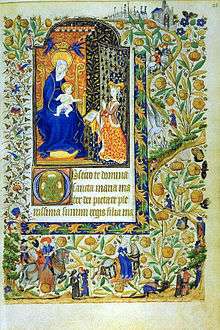Margaret, Countess of Vertus
| Margaret | |
|---|---|
| Countess of Vertus and Etampes | |
 Detail of a folio from the Book of Hours of Marguerite, c. 1430 | |
| Born | 4 April 1406[1] |
| Died |
24 April 1466 (aged 60) Abbey at Guiche, Order of Sainte Claire near Blois |
| Burial | Abbey at Guiche, Order of Sainte Claire near Blois |
| Spouse | Richard of Brittany, Count of Étampes |
| Issue among others |
Francis II, Duke of Brittany Catherine, Princess of Orange |
| House |
House of Valois House of Montfort (by marriage) |
| Father | Louis I, Duke of Orléans |
| Mother | Valentina Visconti |
| Religion | Roman Catholicism |
Margaret, Countess of Vertus (French: Marguerite d'Orléans), was born on 4 December 1406. She was the daughter of Louis I, Duke of Orléans, and Valentina Visconti, and the granddaughter and niece of King Charles V of France and King Charles VI of France, respectively. Her mother was the daughter of Gian Galeazzo Visconti, Duke of Milan, and Isabella of France, who was a daughter of King John II of France. Her brother was the famous and unfortunate Charles, Duke of Orléans, (father of the future Louis XII of France), captured at Agincourt and imprisoned for twenty-five years in England and who during his long captivity, became the greatest poet of the 15th century in the French language.
Life and marriage
In 1423 she married Richard of Montfort, son of John IV, Duke of Brittany, and Joanna of Navarre, later Queen of England as wife of Henry Bolingbroke. Margaret succeeded her brother Philip as Countess of Vertus.[2] She and Richard had seven children, of whom only two, Francis and Catherine, would have progeny.[3] In 1458 Francis succeeded his uncle Arthur III as Duke of Brittany. Margaret, widowed in 1438, lived for a long time at Longchamp and in other monasteries with her younger daughters, Margaret and Madeleine (who was born after her father's death). She was a very pious woman.[4]
The Book of Hours of Marguerite d'Orleans (see below), a defining example of the Illustrated Prayer Book of the Fifteenth Century, was made for her so that she might practice her devotion on a daily basis. She obtained a declaration from the Cardinal of Estouteville that sheltered her liberty and that of her daughters as they moved among the convents and religious monasteries of northern France. She finally retired to the Abbey at Guiche, order of Sainte Claire near Blois, where she died April 24, 1466 at the age of sixty.
Issue
- Marie of Brittany (22 June 1424 – 9 October 1477), Abbess of Fontevrault since 1457 until her death.
- Isabelle of Brittany (2 February 1426 – 9 February 1438).
- Catherine of Brittany (Nantes, 28 May 1428 – 22 June 1476), Dame de l'Epine-Gaudin; married on 19 August 1438 to William VII of Chalon, Prince of Orange, Count of Penthièvre and Seigneur de Cerlier.
- Francis II, Duke of Brittany (23 June 1435 – 9 September 1488)
- Unnamed son (b. 1436 – d. 19 December 1436).
- Margaret of Brittany (22 November 1437 – 1466), a nun.
- Madeleine of Brittany (1 May 1439 – 29 March 1462), a nun.
Succession dispute to the County of Étampes

With her father's death, Margaret inherited the rights to the County of Étampes, and was named countess with her husband as count, in 1423, which was recovered from the crown lands after the death in 1416, of its last incumbent lord, John, Duke of Berry.[5] However, the claim was disputed by the then Duke of Burgundy, Philip the Good, who succeeded his father John the Fearless in 1419 after the latter's assassination by the agents of Dauphin Charles. Philip took possession and ruled the county personally, (possibly wresting it from Richard in vengeance of his father's death) till 1434, after which he gave it to John II, Count of Nevers, his first cousin, who kept it in peaceful possession, until it was reverted to Richard in September 1435 (who died in 1438) by the former Dauphin, who was now King Charles VII of France.[6] The new king confirmed his gift to the deceased duke by letters patent presented to his widow in 1442. However, this decision was contested by the Attorney General of the Parlement, who argued that the County should have been reunited with the Crown, after the death of Richard.[7] It was taken back from Margaret's son Francis in 1478 and in the month of April of the following year, Charles's son and successor, King Louis XI gave it to John of Foix, Viscount of Narbonne, whose wife Marie of Orleans was a niece of Margaret and sister of the future Louis XII of France.
Legacy
Margaret is best remembered for the Book of Hours produced for her. One of the most exquisite examples of fifteenth-century French illumination, this Book of Hours was executed in a complex series of stages, starting with the text as early as 1421, its decoration inspired by diverse sources and artists. The miniature showing Margaret praying to the Virgin served as the source for the historical lithographs of Margaret published by Delpech in 1820.
Ancestry
| Ancestors of Margaret, Countess of Vertus | ||||||||||||||||||||||||||||||||||||||||||||||||||||||||||||||||||||||||||||||||||||||||||||||||||||||||||||||||||||||||||||||||||||||||||||||||||||||||||||||||||||||||||||||||||||||||||||||||||||||||||||||||||||||||||||||||||||||||||||||||||||||||||||||||||||||||||||||||||||||||||||||||||||||||||||||||||||||||||||||||||||||||||||||||||||||||||||||||||||||||||||||||||||||||||||||||||||||||||||||||||||||||||||||||||||||||||||||||||||||||||||||||||||||||||||||||||||||||||||||||||||||||||||||||||||||||||||||||||
|---|---|---|---|---|---|---|---|---|---|---|---|---|---|---|---|---|---|---|---|---|---|---|---|---|---|---|---|---|---|---|---|---|---|---|---|---|---|---|---|---|---|---|---|---|---|---|---|---|---|---|---|---|---|---|---|---|---|---|---|---|---|---|---|---|---|---|---|---|---|---|---|---|---|---|---|---|---|---|---|---|---|---|---|---|---|---|---|---|---|---|---|---|---|---|---|---|---|---|---|---|---|---|---|---|---|---|---|---|---|---|---|---|---|---|---|---|---|---|---|---|---|---|---|---|---|---|---|---|---|---|---|---|---|---|---|---|---|---|---|---|---|---|---|---|---|---|---|---|---|---|---|---|---|---|---|---|---|---|---|---|---|---|---|---|---|---|---|---|---|---|---|---|---|---|---|---|---|---|---|---|---|---|---|---|---|---|---|---|---|---|---|---|---|---|---|---|---|---|---|---|---|---|---|---|---|---|---|---|---|---|---|---|---|---|---|---|---|---|---|---|---|---|---|---|---|---|---|---|---|---|---|---|---|---|---|---|---|---|---|---|---|---|---|---|---|---|---|---|---|---|---|---|---|---|---|---|---|---|---|---|---|---|---|---|---|---|---|---|---|---|---|---|---|---|---|---|---|---|---|---|---|---|---|---|---|---|---|---|---|---|---|---|---|---|---|---|---|---|---|---|---|---|---|---|---|---|---|---|---|---|---|---|---|---|---|---|---|---|---|---|---|---|---|---|---|---|---|---|---|---|---|---|---|---|---|---|---|---|---|---|---|---|---|---|---|---|---|---|---|---|---|---|---|---|---|---|---|---|---|---|---|---|---|---|---|---|---|---|---|---|---|---|---|---|---|---|---|---|---|---|---|---|---|---|---|---|---|---|---|---|---|---|---|---|---|---|---|---|---|---|---|---|---|---|---|---|---|---|---|---|---|---|---|---|---|---|---|---|---|---|---|---|---|---|---|---|---|---|---|---|---|---|---|---|---|---|---|---|---|---|---|---|---|---|---|---|---|---|---|---|---|---|---|---|---|---|---|---|---|---|---|---|---|---|---|---|---|---|---|---|---|---|---|---|---|---|---|---|---|---|---|---|---|---|---|---|---|---|---|---|---|---|---|---|---|---|---|---|---|---|---|---|---|---|---|---|---|---|---|---|---|---|---|---|
| ||||||||||||||||||||||||||||||||||||||||||||||||||||||||||||||||||||||||||||||||||||||||||||||||||||||||||||||||||||||||||||||||||||||||||||||||||||||||||||||||||||||||||||||||||||||||||||||||||||||||||||||||||||||||||||||||||||||||||||||||||||||||||||||||||||||||||||||||||||||||||||||||||||||||||||||||||||||||||||||||||||||||||||||||||||||||||||||||||||||||||||||||||||||||||||||||||||||||||||||||||||||||||||||||||||||||||||||||||||||||||||||||||||||||||||||||||||||||||||||||||||||||||||||||||||||||||||||||||
References
- ↑ http://roglo.eu/roglo?lang=en;i=3599233
- ↑ http://www.genealogics.org/getperson.php?personID=I00004912&tree=LEO
- ↑ http://www.genealogics.org/getperson.php?personID=I00004912&tree=LEO
- ↑ http://berryhillsturgeon.com/BSL/France/1452PleaforIndulgences/PleaForInduldences.html
- ↑ http://www.corpusetampois.com/index-seigneurs.html
- ↑ http://www.corpusetampois.com/index-seigneurs.html
- ↑ http://www.corpusetampois.com/index-seigneurs.html
| Regnal titles | ||
|---|---|---|
| Preceded by Philip |
Countess of Vertus 1420–1466 with Richard |
Succeeded by Francis II, Duke of Brittany |